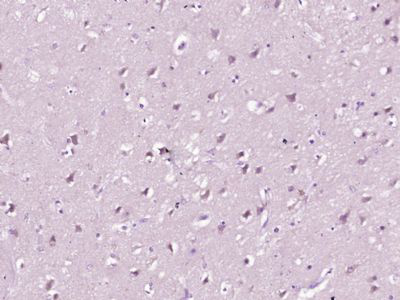产品货号 : mlR2389
英文名称 : Coxsackie Adenovirus Receptor
中文名称 : 柯萨奇病毒蛋白受体B抗体
别 名 : 46 kD coxsackievirus and adenovirus receptor CAR protein; 46 kD coxsackievirus and adenovirus receptor protein; CAR; CAR4/6; Coxsackie virus and adenovirus receptor; Coxsackie virus B receptor; Coxsackievirus and adenovirus receptor; Coxsackievirus B adenovirus receptor; Coxsackievirus B-adenovirus receptor; CVB3 binding protein; CVB3-binding protein; Cxadr; CXAR_HUMAN; hCAR; HCVADR.
研究领域 : 细胞生物 免疫学 微生物学 信号转导 细胞骨架
抗体来源 : Rabbit
克隆类型 : Polyclonal
交叉反应 : Human, Mouse, Rat, Dog, Pig, Cow, Horse, Rabbit,
产品应用 : ELISA=1:500-1000 IHC-P=1:400-800 IHC-F=1:400-800 Flow-Cyt=1μg/Test IF=1:100-500 (石蜡切片需做抗原修复)
not yet tested in other applications.
optimal dilutions/concentrations should be determined by the end user.
分 子 量 : 38kDa
细胞定位 : 细胞膜 分泌型蛋白
性 状 : Lyophilized or Liquid
浓 度 : 1mg/ml
免 疫 原 : KLH conjugated synthetic peptide derived from human Coxsackie Adenovirus Receptor:21-120/365
亚 型 : IgG
纯化方法 : affinity purified by Protein A
储 存 液 : 0.01M TBS(pH7.4) with 1% BSA, 0.03% Proclin300 and 50% Glycerol.
保存条件 : Store at -20 °C for one year. Avoid repeated freeze/thaw cycles. The lyophilized antibody is stable at room temperature for at least one month and for greater than a year when kept at -20°C. When reconstituted in sterile pH 7.4 0.01M PBS or diluent of antibody the antibody is stable for at least two weeks at 2-4 °C.
PubMed : PubMed
产品介绍background:
Coxsackie and adenovirus receptor (CAR), also known as CXADR is a component of the epithelial apical junction complex that is essential for the tight junction integrity. It is a type I membrane receptor for group B coxsackieviruses and subgroup C adenoviruses. Pseudogenes of this gene are found on chromosomes 15, 18, and 21.It is proposed to function as a homophilic cell adhesion molecule and recruits MPDZ to intercellular contact sites. CAR is probably involved in transepithelial migration of polymorphonuclear leukocytes (PMN) through adhesive interactions with AMICA1/JAML located in the plasma membrane of PMN.
Function:
Component of the epithelial apical junction complex that is essential for the tight junction integrity. Proposed to function as a homophilic cell adhesion molecule. Recruits MPDZ to intercellular contact sites. Probably involved in transepithelial migration of polymorphonuclear leukocytes (PMN) through adhesive interactions with AMICA1/JAML located in the plasma membrane of PMN.
Subunit:
Monomer. Probably homodimer formed by 2 molecules on adjacent cells. Interacts with LNX, MPDZ, BAIAP1, DLG4, PRKCABP, TJP1 and CTNNB1. Secreted isoform 3, isoform 4 and isoform 5 can interact with the extracellular domain of the receptor. Interacts with adenovirus subgroup A, C, D, E and F fiber proteins as well as coxsackievirus B1, B2, B3, B4, B5 and B6 capsid proteins and acts as a receptor for these viruses.
Subcellular Location:
Isoform 1: Cell membrane; Single-pass type I membrane protein. Cell junction, tight junction. Cell junction, adherens junction. Basolateral cell membrane; Single-pass type I membrane protein. Note=In epithelial cells localizes to the apical junction complex composced of tight and adherens junctions. In airway epithelial cells localized to basolateral membrane but not to apical surface.
Isoform 2: Cell membrane; Single-pass type I membrane protein. Cell junction, tight junction. Cell junction, adherens junction. Basolateral cell membrane; Single-pass membrane protein. Note=In epithelial cells localizes to the apical junction complex composced of tight and adherens junctions. In airway epithelial cells localized to basolateral membrane but not to apical surface.
Isoform 3: Secreted.
Isoform 4: Secreted.
Isoform 5: Secreted.
Tissue Specificity:
Expressed in pancreas, brain, heart, small intestine, testis, prostate and at a lower level in liver and lung. Isoform 5 is ubiquitously expressed. Isoform 3 is expressed in heart, lung and pancreas. In skeletal muscle, isoform 1 is found at the neuromuscular junction and isoform 2 is found in blood vessels. In cardiac muscle, isoform 1 and isoform 2 are found at intercalated disks. In heart expressed in subendothelial layers of the vessel wall but not in the luminal endothelial surface. Expression is elevated in hearts with dilated cardiomyopathy.
Post-translational modifications:
N-glycosylated (By similarity).
Palmitoylated on Cys-259 and/or Cys-260; required for proper localization to the plasma membrane.
Similarity:
Contains 2 Ig-like C2-type (immunoglobulin-like) domains.
SWISS:
P78310
Gene ID:
1525
Important Note:
This product as supplied is intended for research use only, not for use in human, therapeutic or diagnostic applications.
产品图片












